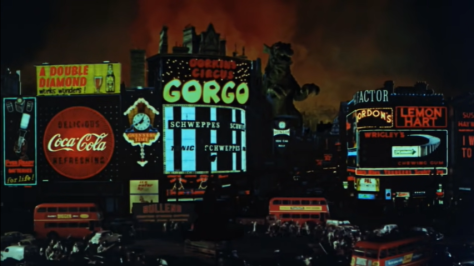
The Movie Monster Game, well, it’s a game about movie monsters. Released in 1986 (the same year as the even more famous giant monster game Rampage) for the Apple II and Commodore 64 and developed by Epyx, a company that gained a name for itself in the eighties PC game space with titles like Impossible Mission and California Games, it comes from a very different epoch than the previous giant monster-based game I’ve written about, a strange and experimental time when game design didn’t always have clear rules, and where a degree of abstraction was still present as a game could only convey so much visual information (Epyx’s earlier giant monster title, Crush, Crumble and Chomp!, a strategy game released in 1981, provides an even primitive-looking example.) Despite that, The Movie Monster Game actually shares a lot in common with later entries in this category, especially in the presentation–decades before War of the Monsters surrounded itself with a nostalgic metafiction wrapper, Epyx went even further, not just basing its menus around a movie theatre motif (complete with “trailers” for other Epyx games that appear before you begin playing), but structuring their game as essentially a movie you construct from various component parts pulled from numerous giant monster movies across the subgenre’s history. Even this far back, you can see that the artifice of these stomp-em-ups, and the context of the audience itself, was considered an indelible part of the experience.
That’s all well and good, but there’s a major advantage that The Movie Monster Game has that even later creature feature games could not pull off: alongside a group of “original” monsters that directly homage specific movies and tropes, they managed to officially licence Godzilla from Toho, putting the King of the Monsters prominently on the package for all to see, and making it the first video game released outside of Japan to feature him. Epyx was not an unknown company in 1986, but even so, getting the sometimes fickle Toho to lend out their star monster to an American game developer at that point still seems like a feat (it is equally surprising that they agreed to let Godzilla and Pals appear in the recent indie brawler GigaBash, a game that I still intend to play.) This was not long after the release of The Return of Godzilla (and its English release Godzilla 1985), which at least put it outside the lowest periods for the franchise, and leads me to believe that this collaboration was not an act of desperation–maybe they were just feeling generous. In any case, Godzilla’s fully approved presence in something with as definitive a title as The Movie Monster Game certainly gives it an air of legitimacy.






